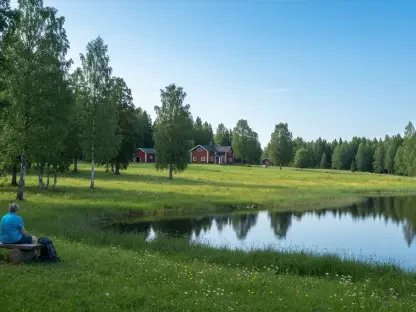In a surprising turn of events, Indianapolis has emerged as a standout on Conde Nast’s list of top U.S. destinations for 2026, capturing the attention of travel enthusiasts nationwide with its remarkable transformation. Once overlooked by many as merely an industrial hub, the Circle City has undergone a dramatic shift, blending sustainable urban planning with vibrant cultural offerings. This roundup gathers insights, opinions, and tips from various travel experts, urban planners, and tourism boards to unpack why Indianapolis is leading the charge in redefining American travel. The purpose of this collection is to highlight diverse perspectives on the city’s rise, compare differing views on its developments, and offer practical advice for travelers eager to explore this evolving destination.
Unpacking the Circle City’s Meteoric Rise
Insights from travel industry leaders reveal a consensus that Indianapolis’s ascent is no accident but a result of deliberate, forward-thinking initiatives. Many point to the city’s focus on community-driven tourism as a key driver, noting how investments in pedestrian infrastructure and green spaces have reshaped its appeal. A common theme among commentators is the city’s ability to balance modernity with accessibility, making it a model for other mid-sized urban centers aiming to attract global visitors.
Differing opinions emerge when discussing the pace of this transformation. Some urban analysts argue that the rapid changes risk losing the city’s authentic charm, warning that overdevelopment could alienate locals who value its small-town feel. Others counter that such growth is essential to compete with larger destinations like Chicago, emphasizing that strategic planning has kept community needs at the forefront. This debate underscores a broader tension in urban tourism about maintaining identity amid progress.
A recurring tip from travel bloggers centers on timing a visit to coincide with major events hosted in the city, such as festivals along revitalized riverfronts, to experience its dynamic energy firsthand. Their advice often highlights the importance of exploring beyond downtown to understand the full scope of Indianapolis’s evolving narrative. These varied perspectives set the stage for a deeper look into specific factors fueling the city’s newfound status.
Key Factors Behind Indianapolis’s Recognition
Pedestrian Progress: Trails and Bike-Friendly Innovations
Travel reviewers consistently praise Indianapolis for its remarkable expansion of trails and bike lanes, with many spotlighting the Nickel Plate Trail as a transformative project for connectivity. Reports indicate an addition of 38 miles of new trails to an already robust 77-mile network, a statistic often cited as evidence of the city’s commitment to outdoor accessibility. This infrastructure has earned high marks for positioning Indianapolis as a top bike-friendly hub in national rankings.
Urban planners offer a more nuanced take, acknowledging the challenge of balancing such developments with the preservation of green spaces. Some express concern that unchecked expansion could encroach on natural habitats, urging careful zoning to protect these areas. Others highlight the city’s proactive approach, noting public consultations as a way to ensure sustainable growth that benefits both residents and visitors.
Tips from cycling enthusiasts frequently mention using the newly launched interactive trailways map to navigate the city’s paths efficiently. Their advice often extends to exploring lesser-known routes for a quieter, more immersive experience of local landscapes. These insights collectively paint a picture of a city prioritizing active lifestyles while grappling with the complexities of urban planning.
Riverfront Renaissance: White River’s Tourism Appeal
Feedback from tourism boards emphasizes the revitalization of White River State Park as a cornerstone of Indianapolis’s allure, with waterway cleanups and new recreational options like kayaking drawing significant attention. The park’s transformation has led to accolades such as being dubbed “America’s newest river city,” a title that reflects its growing status among nature-focused travelers. Enhanced infrastructure, including the Henry Street Bridge, is often cited as improving access to this scenic gem.
Environmental advocates, however, raise concerns about the risks of overtourism in such natural spaces, pointing to potential strain on ecosystems if visitor numbers surge unchecked. Their perspective contrasts with tourism promoters who see opportunities for sustainable growth through eco-friendly initiatives like guided tours with minimal environmental impact. This divergence highlights the need for careful management to maintain the park’s long-term viability.
Practical suggestions from travel guides include visiting during off-peak seasons to enjoy the riverfront’s tranquility and participating in organized water activities for a safe, structured experience. Such tips aim to help tourists appreciate the area’s beauty while minimizing their footprint. Together, these views underscore the delicate balance between showcasing natural assets and preserving them for future generations.
Cultural Hotspot: Arts and Community Creativity
Cultural commentators are abuzz about Indianapolis’s emerging artistic landmarks, such as the Tube Factory and the Factory Arts District, which are redefining the city as a creative epicenter. These spaces are frequently described as must-visit destinations for their innovative exhibits and community engagement, signaling a shift from the city’s industrial past to a vibrant present. Local venues like Daisy Bar and wellness hubs like MVMT House also receive nods for adding unique lifestyle elements to the cultural mix.
Some critics, however, question whether this cultural boom can sustain momentum without broader national recognition, suggesting that marketing efforts must expand to draw international art lovers. In contrast, local boosters argue that grassroots growth ensures authenticity, predicting that organic interest will build over time. This split in opinion reveals differing priorities between immediate visibility and long-term cultural depth.
Travel tips from art bloggers often focus on exploring these districts during special events or openings to catch live performances and exhibitions. They also recommend seeking out smaller, independent galleries for a more intimate look at the city’s creative pulse. These diverse insights illustrate how Indianapolis is crafting a fresh identity as a destination for cultural exploration.
Economic Strength: Infrastructure and Business Growth
Economic analysts highlight Indiana’s top ranking for road quality as a significant boost to Indianapolis’s tourism and business appeal, creating a seamless experience for visitors navigating the region. This statewide achievement is often mentioned alongside the city’s own infrastructure projects, positioning it favorably against other listed destinations like Sacramento. Many see this as a foundation for sustained economic growth that benefits both tourists and locals.
Opinions vary on the potential longevity of this boom, with some industry observers cautioning that continued investment is crucial to avoid stagnation. Others are more optimistic, pointing to ongoing projects as evidence of a commitment to maintaining momentum through at least 2027. These contrasting forecasts reflect broader uncertainties about how mid-tier cities can maintain relevance in a competitive travel landscape.
Practical advice from business travel experts includes leveraging the city’s improved connectivity for conferences and events, which often offer a cost-effective alternative to larger urban centers. They also suggest combining business trips with leisure activities to fully appreciate the city’s dual appeal. Such perspectives emphasize how economic developments are creating a multifaceted destination with wide-ranging benefits.
Final Reflections on Indianapolis’s Spotlight
Looking back, the roundup of opinions and insights revealed a shared admiration for Indianapolis’s remarkable journey to becoming a top U.S. destination for 2026. From trail expansions to riverfront revivals and cultural innovations, the city’s multifaceted approach garnered praise across various sectors. Differing views on sustainability and the pace of growth added depth to the discussion, highlighting the complexities of urban transformation.
For those inspired by this narrative, the next step could involve planning a visit to experience the Circle City’s offerings firsthand, using interactive maps and seasonal guides to navigate its treasures. For other cities looking to replicate this success, studying Indianapolis’s blend of community focus and infrastructure investment might provide valuable lessons. Exploring further resources on sustainable tourism and urban renewal could also deepen understanding of how such destinations shape the future of American travel.









